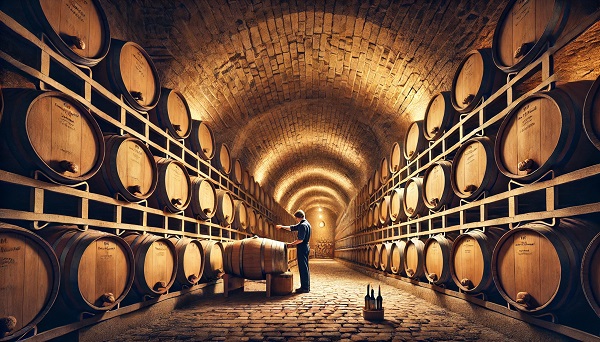Oak Maturation
Factors Influencing the Style and Quality of Wine

Maturation plays a crucial role in shaping the style, quality, and price of wine.
Oak Maturation
Many quality wines are matured in oak vessels to add complexity, flavor, and texture. Extended oak aging is often associated with higher-priced wines due to the cost of barrels and the investment in time.
Oak vessels can impart various flavors, aromas, and textures to the wine. Different types of oak (French, American, Hungarian) and characteristics (toast level, barrel age, barrel size) influence the style and quality of the wine.
In oak vessels, the wine undergoes a controlled Oxygenation and absorb oak compounds an flavors like smoke, vanilla, toast, and spices, as well as the oak enhance the complexity and structure of the wine.
Vessel Size
Oak vessels used in winemaking come in various sizes, each with its own name and specific use.
The size of the barrels plays a vital part. Small barrels have stronger effect than large barrels.
Small Barrels (Barrique, Pièce) impart significant oak influence. This is ideal for wines where the winemaker wants noticeable oak flavors and aromas.
Medium-Sized Barrels (Puncheon, Demi-Muid, Butt) provide a balance between oak influence and the natural expression of the wine. This is suitable for wines with longer aging periods or those requiring subtle oak integration.
Large Vats (Foudre, Botti) impart minimal oak flavor, focusing on long aging, gentle oxidation, and preserving the wine’s varietal character and terroir.
Each vessel size influences the wine in different ways, with smaller barrels typically imparting more oak influence and larger vessels allowing for more subtle interactions between the wine and oxygen, creating complexity without overwhelming the wine’s natural qualities.
Barrel Age
The age of the barrels plays a vital part. Absorption is highest in new barrels and much less in used barrels.
Many famous Bordeaux and Burgundy wines are matured in new barrels. Sometimes these wines can be over-oaked. Many producers prefer to work with a mix of new and old barrels.
Toasting Level
Heavy toasted barrels have stronger effect than light toasted barrels.

Light Toast: More delicate, bready, and vanilla notes.
Medium Toast: Balances sweet spices, caramel, and toast.
Heavy Toast: Intense flavors like smoke, char, coffee, and chocolate.
Oak Vessel Size
Barrique
225 liters (59 gallons) Origin: Bordeaux, France
Commonly used for aging both red and white wines, particularly in Bordeaux and many New World regions. The barrique is known for imparting significant oak influence due to its relatively high surface area-to-volume ratio.
Pièce
228 liters (60 gallons) Origin: Burgundy, France
Standard barrel size in Burgundy, used primarily for aging Pinot Noir and Chardonnay. Similar in size to the barrique, but specific to Burgundy winemaking traditions.
Bordeaux Hogshead
300 liters (79 gallons) Origin: Bordeaux, France
Slightly larger than a barrique, offering a more subtle oak influence due to the lower surface area-to-volume ratio. It is used for longer aging or for wines where less oak flavor is desired.
Hogshead
300 liters (79 gallons) Origin: Australia
Common in Australia for aging wines, particularly Shiraz. Like the Bordeaux hogshead, it offers a more moderate oak influence compared to smaller barrels.
Puncheon
450-500 liters (119-132 gallons) Origin: Various regions, including Australia and Spain
Larger than a barrique or hogshead, puncheons provide a softer oak influence due to the lower surface area-to-volume ratio. They are often used for aging wines where oak is desired but not dominant, such as certain Chardonnays or red wines with longer aging times.
Demi-Muid
600 liters (158 gallons) Origin: Rhône Valley, France
Common in the Rhône Valley and other French regions for both fermentation and aging. Due to its larger size, it imparts less oak influence compared to smaller barrels, making it suitable for wines that need subtle oak integration.
Butt
475-500 liters (125-132 gallons) Origin: Jerez, Spain (also used in Portugal)
Traditionally used for aging sherry and port. Butts are larger barrels that allow for slow aging and gentle oxidation, contributing to the development of complex flavors in fortified wines.
Tonneau
900 liters (238 gallons) Origin: Bordeaux, France
Larger than a barrique or puncheon, the tonneau is used for aging wine when a more subtle oak influence is desired. It's less common than the barrique but still used in certain winemaking practices.
Château Foudre
2,000-12,0000 (528-3,170 gallons) Origin: France
Large oval or cylindrical vats commonly used in traditional winemaking regions like the Rhône Valley and Alsace. Foudres are used for fermenting or aging wines, offering minimal oak influence while allowing for slow, controlled micro-oxygenation.
Botti
1,000-6,000 liters (264-1,585 gallons) Origin: Italy
Large oval vats traditionally used in Italy for fermenting and aging wines, particularly in regions like Tuscany and Piedmont. Botti allow for long aging periods with minimal oak influence, ideal for preserving the wine’s natural characteristics.
Foudre
2,000-10,000 liters (528-2,641 gallons) Origin: France and Germany (Rhône and Alsace)

Very large wooden vats used for fermenting or aging wine. Foudres provide minimal oak flavor due to the large size, but they allow for slow oxidation, contributing to the development of complex wine textures and flavors over time.

